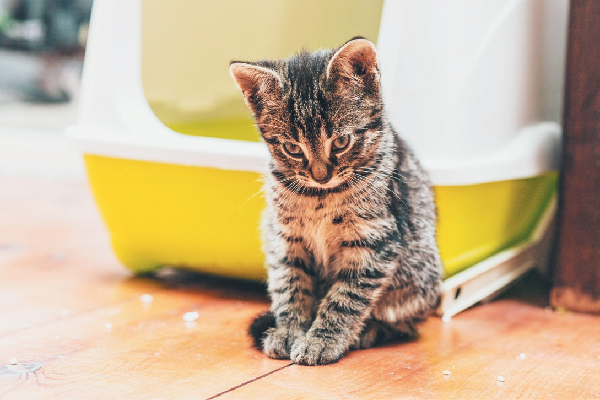Is your cat not using the litter box? Use this checklist to see what problems are at play — and if you need to take your cat to the vet.
1. Medical issues.

With a cat not using the litter box, you may need to take him to a vet. Medical issues, like urinary tract disorders, are a common — and serious — reason for a cat not using the litter box.
2. Litter box size.
Ideally, your cat’s box should be large enough for him to comfortably turn around inside, without his body hanging over the side. You’ll need a smaller litter box for kittens and then bigger when they outgrow it. You’ll also need one with smaller sides for kittens and senior cats so they can get easily in and out of it.
3. Litter box or litter type.
Just like us, cats have their own bathroom preferences and a cat not using the litter box might not like the type of litter or the type of litter box.
Some cats like a covered litter box and other cats prefer one that’s uncovered. There are many types of litter boxes out there, so try a variety of them and find out which one your cat prefers.
The same goes for litter. Cats with sensitive paws are quite particular about the type of litter they use. With all the choices, get several that work for you and your cat, and offer them in different litter boxes to see which one your cat prefers.
4. Box placement.
A cat not using the litter box might have difficultly accessing the litter box. Place the litter box in a low-traffic area of your home but not somewhere difficult for your cat to reach. If you have a kitten or senior cat, put a box on every level of your home, so he can get to a box quickly and easily.
5. Stress.
Household changes can quickly cause stress in your cat, and peeing outside of the litter box is commonly the first sign. Adding new people or pets to the household is a common cat stressor.
6. Not enough boxes — or not clean enough.
If there aren’t enough boxes in a multi-cat household, or if they are not scooped often enough, your cats will find another, cleaner place to go. And I guarantee it won’t be someplace you’ll like. Scoop your litter boxes often, at least twice a day, and offer the same number of boxes as you have cats and one extra.
Thumbnail: Photography ©ysbrandcosijn | Getty Images.
Tell us: What litter box issues have you encountered? What are your tips for a cat who’s not using his litter box?
Rita Reimers’ Cat Behavior Coaching has helped many cat owners better understand their feline friends. Visit RitaReimers.com to read her cat behavior blog or book a cat behavior coaching session. Rita is also CEO/owner of JustForCatsPetSitting.com. Connect with her on Facebook and on Twitter at @TheCatAnalyst.
Editor’s note: This article appeared in Kittens, a special issue from Catster magazine. Look for Kittens on a newsstand near you!








